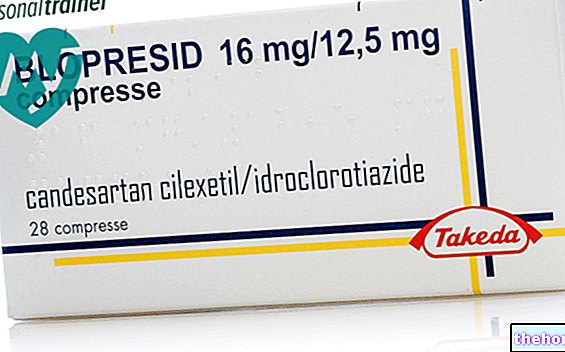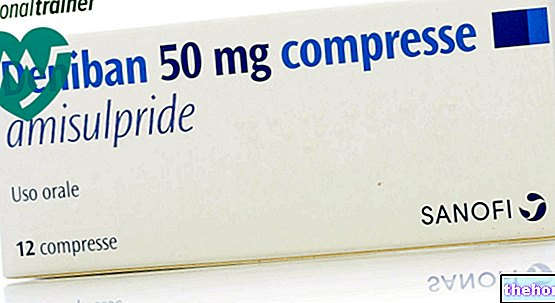Active ingredients: Atenolol, Chlortalidone
Tenoretic 100 mg + 25 mg tablets
Tenoretic package inserts are available for pack sizes:- Tenoretic 100 mg + 25 mg tablets
- Tenoretic 50 mg + 12.5 mg tablets
Indications Why is Tenoretic used? What is it for?
Tenoretic contains two active ingredients: atenolol and chlorthalidone.
Atenolol belongs to a group of medicines called beta-blockers, which work by slowing the heartbeat.
Chlorthalidone belongs to a group of medicines called diuretics, which work by increasing the amount of urine produced by the kidneys.
Tenoretic is indicated for the treatment of high blood pressure (hypertension) in adults when it cannot be controlled with atenolol or chlorthalidone monotherapy alone.
Talk to your doctor if you don't feel better or if you feel worse.
Contraindications When Tenoretic should not be used
Do not take Tenoretic
- if you are allergic to atenolol or chlorthalidone or any of the other ingredients of this medicine (listed in section 6)
- if you are allergic to sulfonamide derivatives (a class of antibiotics with antibacterial action, used in case of infections)
- if you are pregnant or want to become pregnant or if you are breastfeeding
- if you have heart disease, including heart failure that is not controlled by adequate therapy (the heart cannot pump enough blood to meet the needs of the body) or second and third degree heart block (disease of the conduction system of the heart )
- if you suffer from reduced or irregular heartbeats, very low blood pressure, severe circulatory problems
- if you have a cancer called 'pheochromocytoma' that is not being treated (usually this cancer develops near a kidney and can cause high blood pressure)
- if you have severe kidney problems
- if your doctor has diagnosed you with higher than normal levels of acids in your blood (metabolic acidosis).
If you find yourself in any of the above situations, please tell your doctor.
Precautions for use What you need to know before taking Tenoretic
Talk to your doctor or pharmacist before taking Tenoretic:
- if you have problems with your thyroid gland (a gland in your neck), the medicine may hide the symptoms of thyrotoxicosis, such as fast heartbeat, tremor and excessive sweating
- if you have diabetes (a disease characterized by an excess of sugar in the blood)
- if you suffer from heart problems or blood circulation problems even if controlled by adequate therapy
- if you suffer from breathing problems or asthma
- if you have a tumor called 'pheochromocytoma that is being treated
- if you have electrolyte imbalances in your blood (changes in the concentrations of salts, such as sodium and potassium, which are normally dissolved in the blood)
- if you have liver problems
- if you suffer from a type of chest pain called "Prinzmetal's angina"
- if you have ever had allergic reactions in the past (for example from insect bites)
- if you are to be given a type of medicine called anesthetics (medicines that are given for example during surgery)
- if you are taking ophthalmic beta-blockers (medicines that lower internal pressure in the eye), as they can increase the effects of medicines similar to Tenoretic,
- if you suffer from first degree heart block (disease of the heart's conduction system).
Reduced heart rate (number of heart beats per minute)
You may experience a decrease in your heart beat during treatment with Tenoretic (see section "Possible side effects"). This effect is normal, but if you worry about it, consult your doctor.
Diabetes or hypoglycemia (low blood sugar levels)
If you have diabetes and are being treated with antidiabetics (medicines to treat diabetes), this medicine can raise your blood sugar levels. This generally causes the heart to beat faster.
Uricemia (uric acid in the blood)
In prolonged treatments Tenoretic can cause an increase in the levels of uric acid in the blood, which can cause gout (a disease that causes pain in the joints). Your doctor will advise you on the appropriate therapy.
Anesthesia
If you are to be hospitalized, you must inform the medical staff of your treatment with Tenoretic and, in particular, the anesthetist (the doctor who deals with the anesthesia) in case of surgery.
For those who carry out sports activities
The use of the drug without therapeutic necessity constitutes doping and can in any case determine positive anti-doping tests.
Children and adolescents
Tenoretic should not be given to children and adolescents under the age of 18.
Interactions Which drugs or foods can modify the effect of Tenoretic
Tell your doctor or pharmacist if you are taking, have recently taken or might take any other medicines.
In particular, tell your doctor if you are taking any of the following medicines:
- medicines to treat irregular heartbeats (amiodarone, disopyramide or other antiarrhythmics
- lithium (medicine used for certain mental disorders)
- analgesics such as indomethacin or ibuprofen (medicines used for pain and inflammation)
- medicines to treat high blood pressure or chest pain (particularly verapamil, diltiazem, clonidine, or nifedipine). Before starting treatment with Tenoretic it is necessary that at least 48 hours have passed since the suspension of any previous therapy with verapamil or diltiazem, or vice versa.
- medicine to treat heart failure (digoxin, a medicine used for heart disorders)
- nasal decongestants or other medicines (which contain for example pseudoephedrine) to treat colds.
- clonidine (medicine to treat high blood pressure or to prevent migraine). If you are taking clonidine and Tenoretic together do not stop taking clonidine or Tenoretic without first consulting your doctor
- medicines such as adrenaline (medicine that stimulates the heart)
- baclofen (medicine used to treat muscle cramps)
Warnings It is important to know that:
Pregnancy and breastfeeding
If you are pregnant, think you may be pregnant or are planning to have a baby, or if you are breast-feeding do not take Tenoretic (see section 2 "Do not take Tenoretic").
Driving and using machines
Taking Tenoretic is unlikely to affect your ability to drive and use machines.
However, dizziness and fatigue can sometimes occur; in case of these symptoms it is advisable not to carry out these activities.
Dose, Method and Time of Administration How to use Tenoretic: Posology
Always take this medicine exactly as your doctor or pharmacist has told you. If in doubt, consult your doctor or pharmacist.
The tablets should be taken whole with a little water, preferably always at the same time.
Adults
The recommended dose is one tablet a day.
Senior citizens
If you are elderly, your doctor may decide to prescribe a lower dose of Tenoretic.
If you have severe kidney problems
If you suffer from severe kidney problems you should not take Tenoretic (see section "Do not take Tenoretic").
Use in children and adolescents
Tenoretic should not be given to children and adolescents under the age of 18.
If you forget to use Tenoretic
Do not take a double dose to make up for a forgotten tablet.
In case you forget to take a dose, it should be taken as soon as possible. Two doses should not be taken at the same time.
If you stop using Tenoretic
Improved health should not lead to discontinuation of treatment unless directed to do so by your doctor.
Discontinuation of treatment should take place gradually.
If you have any further questions on the use of this medicine, ask your doctor or pharmacist.
Overdose What to do if you have taken too much Tenoretic
In case of accidental ingestion / intake of an excessive dose of Tenoretic, notify your doctor immediately or go to the nearest hospital.
You may have a slow heart rate, dizziness caused by low blood pressure and difficulty breathing. Your heart may also struggle to supply blood to the rest of your body (acute heart failure).
Side Effects What are the side effects of Tenoretic
Like all medicines, this medicine can cause side effects, although not everybody gets them.
During treatment with Tenoretic, as with any drug, the following side effects may occur at the following frequency:
Common (may affect up to 1 in 10 patients):
- slow heartbeats
- cold fingers and toes
- stomach and intestinal disorders (e.g. nausea, diarrhea)
- tiredness
- increase in blood uric acid levels, decrease in blood potassium levels, decrease in blood sodium levels (which can cause weakness, vomiting and cramps), impaired glucose tolerance (condition which can lead to increased blood sugar ).
Uncommon (may affect up to 1 in 100 patients):
- sleep disorders
- changes in blood tests related to liver function (transaminases)
Rare (may affect up to 1 in 1000 patients):
- purpura (purple spots on the skin), thrombocytopenia (reduction in the number of platelets in the blood, which can manifest as bruising), leukopenia (reduction in the number of white blood cells, a type of blood cell)
- mood changes, nightmares, confusion, psychosis (mental disorders) and hallucinations (seeing unexplained things)
- dizziness especially when standing, headache, tingling in the hands
- dry eyes, visual disturbances
- difficulty breathing and / or swollen ankles if you have heart failure (heart disease)
- heart block (condition which can cause abnormal heart beat, dizziness, tiredness or fainting)
- sudden drop in blood pressure when standing with the possibility of loss of consciousness, worsening of circulatory disturbances, numbness and cramps in the fingers followed by a sensation of heat and pain (Raynaud's phenomenon)
- worsening of breathing difficulties if you have asthma or have suffered from asthma problems
- dry mouth
- jaundice (yellowing of the skin and whites of the eyes), pancreatitis (inflammation of the pancreas, a gland found near the stomach)
- hair loss, skin rashes including worsening of psoriasis (chronic skin inflammation)
- inability to get an erection (impotence).
Very rare (may affect up to 1 in 10,000 patients):
- alteration of laboratory values for the measurement of certain immune reactions (positive test for antinuclear antibodies).
Frequency not known (frequency cannot be estimated from the available data):
- constipation.
Reporting of side effects
If you get any side effects, talk to your doctor or pharmacist. This includes any possible side effects not listed in this leaflet. You can also report side effects directly via the national reporting system at www.agenziafarmaco.gov.it/it/responsabili. By reporting side effects you can help provide more information on the safety of this medicine.
Expiry and Retention
- Do not store above 25 ° C. Store in the original package to protect from light and moisture.
- Keep this medicine out of the sight and reach of children.
- Do not use this medicine after the expiry date which is stated on the carton after EXP. The expiry date refers to the last day of that month.
- Do not throw any medicines via wastewater or household waste. Ask your pharmacist how to dispose of medicines you no longer use. This will help protect the environment.
Deadline "> Other information
What Tenoretic contains
- The active ingredients are: atenolol 100 mg and chlorthalidone 25 mg.
- The other ingredients are: heavy magnesium carbonate, maize starch, sodium lauryl sulfate, gelatin, magnesium stearate.
Description of the appearance of Tenoretic and contents of the pack
Tablets packed in blister packs of 14 tablets and 28 tablets.
Not all packs can be on the market.
Source Package Leaflet: AIFA (Italian Medicines Agency). Content published in January 2016. The information present may not be up-to-date.
To have access to the most up-to-date version, it is advisable to access the AIFA (Italian Medicines Agency) website. Disclaimer and useful information.
01.0 NAME OF THE MEDICINAL PRODUCT -
TENORETIC 100 MG + 25 MG TABLETS
02.0 QUALITATIVE AND QUANTITATIVE COMPOSITION -
One tablet contains active ingredients:
atenolol 100 mg and chlorthalidone 25 mg.
For the full list of excipients, see section 6.1.
03.0 PHARMACEUTICAL FORM -
Tablets.
04.0 CLINICAL INFORMATION -
04.1 Therapeutic indications -
Tenoretic 100 mg + 25 mg is indicated for the treatment of essential hypertension in patients whose blood pressure is not adequately controlled by atenolol or chlorthalidone monotherapy alone.
04.2 Posology and method of administration -
When clinically appropriate, a direct switch from monotherapy to fixed combination should be considered in patients in whom blood pressure is insufficiently controlled.
Adults
The usual maintenance dose of Tenoretic 100 mg + 25 mg is one tablet per day. Most patients with arterial hypertension respond adequately to administration of one tablet of Tenoretic 100 mg + 25 mg per day.
If the response is not considered satisfactory, it is necessary to combine another antihypertensive such as a vasodilator.
Special populations
Use in the elderly
In this group of patients, the dosage of Tenoretic 100 mg + 25 mg, necessary for its therapeutic action, is often lower (Tenoretic atenolol 50 mg and chlorthalidone 12.5 mg).
Use in children and adolescents (
There is no clinical experience with the use of Tenoretic in children and adolescents; therefore it should not be administered to children and adolescents.
Use in patients with impaired renal function
Due to the properties of chlorthalidone, Tenoretic 100 mg + 25 mg shows reduced efficacy in the presence of renal insufficiency. Therefore this fixed dose combination should not be administered to patients with severe renal impairment (see section 4.3).
Use in patients with impaired hepatic function
No dosage adjustments are required in patients with impaired hepatic function.
04.3 Contraindications -
Tenoretic 100 mg + 25 mg should not be administered to patients with any of the following conditions:
• hypersensitivity to atenolol and chlorthalidone (or sulfonamide derivatives) or to any of the excipients.
• 2nd and 3rd degree atrioventricular block;
• sinus node disease;
• bradycardia;
• uncontrolled heart failure;
• cardiogenic shock;
• hypotension;
• severe disturbances of peripheral arterial circulation;
• Severe impairment of renal function;
• metabolic acidosis;
• untreated pheochromocytoma;
• pregnancy and breastfeeding
04.4 Special warnings and appropriate precautions for use -
Due to the presence of the beta-blocker atenolol:
Although Tenoretic 100 mg + 25 mg is contraindicated in heart failure not controlled by adequate therapy (see section 4.3), it can be administered to patients with heart failure as long as it is controlled by adequate therapy and, with due caution, to patients with an adequate poor heart.
In patients with Prinzmetal's angina, Tenoretic 100 mg + 25 mg may increase the number and duration of anginal seizures by alpha receptor mediated coronary arterial vasoconstriction. However, with the utmost caution, its use in these patients can be considered, as atenolol is a selective beta-blocker beta-1.
Although it is contraindicated in the case of severe disturbances of the peripheral arterial circulation (see section 4.3), Tenoretic 100 mg + 25 mg may induce an aggravation of even modest peripheral vascular disorders.
Particular caution in the administration of Tenoretic 100 mg + 25 mg should be given to patients with 1st degree atrioventricular block, due to its negative effect on conduction time.
It can change the signs of hypoglycemia, such as tachycardia, palpitations and sweating.
It can mask the cardiovascular signs of thyrotoxicosis.
Reduction of heart rate is a "pharmacological action induced by" atenolol. Dosage reduction should be considered in the rare cases where symptoms attributable to excessive reduction in heart rate appear.
It is important not to abruptly stop treatment in patients with ischemic heart disease.
In patients with a history of anaphylactic reactions to various allergens, an aggravation of allergic reactions can occur on the occasion of repeated stimuli by the allergen.
These patients may not respond adequately to the doses of adrenaline commonly used in the treatment of allergic reactions.
Patients with bronchospastic disease should, in general, not receive beta-blockers, due to increased airway resistance. Atenolol is a selective beta-blocker beta-1, however this selectivity is not absolute. Therefore, extreme caution is required in these patients, possibly using the lowest possible dose of Tenoretic. In case of increased respiratory tract resistance, Tenoretic 100 mg + 25 mg administration should be discontinued and, if necessary, therapy with bronchodilator preparations (such as salbutamol) initiated.
The systemic effects of oral beta-blockers may be enhanced by concomitant use of ophthalmic beta-blockers.
In patients with pheochromocytoma Tenoretic should only be administered after blockade of alpha receptors. Blood pressure must be closely monitored.
Caution should be exercised in case of concomitant administration of anesthetic agents and Tenoretic. The anesthetist should be informed of this and an anesthetic with the lowest possible negative inotropic activity should be used. The use of beta-blockers and anesthetic drugs may lead to attenuation of reflex tachycardia and increase the risk of hypotension. The use of anesthetics which can cause myocardial depression should be avoided.
Due to the presence of Chlorthalidone
Plasma electrolytes should be determined periodically and at appropriate intervals to detect possible electrolyte imbalances, especially hypokalaemia and hyponatremia.
Hypokalaemia and hyponatremia can occur. Generally, the control of potassium is useful, especially in older patients, in those with heart failure who take digitalis preparations and in subjects who follow a low-potassium diet or who have gastrointestinal disorders. Hypokalaemia can cause arrhythmias in patients receiving digitalis therapy.
Since chlorthalidone can impair glucose tolerance, diabetic patients should be advised of the possible increase in glucose levels. Close monitoring of blood glucose in the initial phase of therapy and monitoring of glucosuria at regular intervals is recommended in prolonged treatment.
In patients with impaired hepatic function or with progressive liver disease, modest alterations in the water and electrolyte balance can induce hepatic coma.
Hyperuricaemia may occur. Usually only a slight increase in uric acid occurs, but if such increases persist over time, concomitant administration of a uricosuric agent can bring uric acid levels back to normal.
04.5 Interactions with other medicinal products and other forms of interaction -
Due to atenolol:
The concomitant use of beta-blockers and calcium channel blockers with negative inotropic effect (eg verapamil, diltiazem), may cause an increase in these effects, particularly in patients with compromised ventricular function and / or sinus or atrial conduction abnormalities. -ventricular. This can lead to severe hypotension, bradycardia and heart failure. Neither beta-blockers nor calcium channel blockers should be administered intravenously within 48 hours of stopping one of these drugs before starting the other therapy.
Class I antiarrhythmic drugs (eg disopyramide) and amiodarone can potentiate the effect on atrial conduction time and induce a negative inotropic effect.
Glycoside-digitalis drugs, associated with beta-blockers, can cause an increase in atrioventricular conduction time.
Beta-blockers can aggravate the sharp rise in blood pressure that can occur after discontinuation of clonidine. If the two drugs are administered at the same time, the beta-blocker must be discontinued several days before stopping the clonidine therapy. If beta-blocker therapy is to replace clonidine therapy, initiation of beta-blocker therapy should occur several days after stopping clonidine therapy.
Sympathomimetic drugs, such as adrenaline, can counteract the effect of beta-blockers when used concurrently.
The concomitant use of prostaglandin synthetase inhibitors (eg ibuprofen and indomethacin) may reduce the hypotensive effects of beta-blockers.
Due to chlorthalidone:
Chlorthalidone can cause decreased renal clearance of lithium, resulting in increased serum concentrations. Therefore, adjustments in the lithium dosage may be necessary.
Due to the combination of the two drugs:
Concomitant therapy with dihydropyridines, e.g. nifedipine, may increase the risk of hypotension, while heart failure may occur in patients with latent heart failure.
Concomitant use of baclofen may potentiate the antihypertensive effect, thus requiring dose adjustments.
04.6 Pregnancy and breastfeeding -
Pregnancy
Tenoretic 100 mg + 25 mg should not be administered during pregnancy.
Feeding time
Tenoretic 100 mg + 25 mg should not be given to women who are breastfeeding.
04.7 Effects on ability to drive and use machines -
Tenoretic 100 mg + 25 mg is unlikely to affect the ability to drive and use machines. However, it should be taken into account that dizziness or fatigue may occasionally occur.
04.8 Undesirable effects -
In clinical studies, the possible undesirable events reported are generally attributable to the pharmacological actions of its components.
The following undesirable effects, classified by body system, have been reported with the following frequencies: very common (≥10%), common (1-9.9%), uncommon (0.1-0.9%), rare (0.01-0.09%) and very rare (
Disorders of the blood and lymphatic system
Rare: purpura, thrombocytopenia, leukopenia (related to chlorthalidone).
Psychiatric disorders
Uncommon: sleep disturbances similar to those reported with other beta-blockers.
Rare: mood changes, nightmares, confusion, psychosis and hallucinations.
Nervous system disorders
Rare: dizziness, headache, paraesthesia.
Eye disorders
Rare: dry eyes, visual disturbances.
Cardiac pathologies
Common: bradycardia.
Rare: worsening of heart failure, precipitation of heart block.
Vascular pathologies
Common: cold in the extremities.
Rare: postural hypotension which may be associated with syncope, aggravation of intermittent claudication if already present, Raynaud's phenomenon in susceptible patients.
Respiratory, thoracic and mediastinal disorders
Rare: Bronchospasm may occur in patients with bronchial asthma or a history of asthma problems.
Gastrointestinal disorders
Common: gastrointestinal disturbances (including nausea related to chlorthalidone).
Rare: dry mouth.
Not known: constipation.
Hepatobiliary disorders
Rare: hepatic toxicity including intrahepatic cholestasis, pancreatitis (related to chlorthalidone).
Skin and subcutaneous tissue disorders
Rare: alopecia, psoriasiform skin reactions, psoriasis aggravation, skin rash.
Musculoskeletal and connective tissue disorders
Not known: lupoid-like syndrome
Diseases of the reproductive system and breast
Rare: impotence.
General disorders and administration site conditions
Common: fatigue.
Diagnostic tests
Common: related to chlorthalidone: hyperuricaemia, hyponatremia, hypokalaemia, impaired glucose tolerance.
Uncommon: increases in transaminase levels.
Very rare: An increase in antinuclear antibodies has been observed, the clinical relevance of which is however unclear.
If, according to clinical judgment, the patient's quality of life is negatively affected by the presence of any of the undesirable effects listed above, discontinuation of treatment should be considered.
04.9 Overdose -
Symptoms of overdose can manifest as bradycardia, hypotension, acute heart failure and bronchospasm.
General supportive measures should include: close medical surveillance, hospitalization in the intensive care unit, gastric lavage, use of activated charcoal and a laxative to prevent absorption of any drug still present in the gastrointestinal tract, use of plasma or substitutes for the gastrointestinal tract. plasma to treat hypotension and shock.
The possibility of using hemodialysis or hemoperfusion should be considered.
Severe bradycardia can be corrected with 1-2 mg of atropine administered intravenously and / or with a cardiac pacemaker. If necessary, this can be followed by a 10 mg intravenous bolus dose of glucagon, which may be repeated or followed by 1-10 mg / h intravenous glucagon depending on response. If there is no response to glucagon or if it is not available, a beta-adrenoceptor stimulant such as dobutamine is used at a dose of 2.5 - 10 mcg / kg / min for intravenous infusion. Dobutamine, due to its positive inotropic effects, can also be used to treat hypotension and acute heart failure.
These doses are likely to be inadequate to counteract the cardiac effects induced by beta-blockade in the event of a large overdose. The Dobutamine dose should then be increased as needed to achieve the desired response based on the patient's clinical condition.
Bronchospasm can usually be resolved by administering bronchodilator preparations.
Excessive diuresis must be countered by keeping the balance between fluid and electrolytes normal.
05.0 PHARMACOLOGICAL PROPERTIES -
05.1 "Pharmacodynamic properties -
Pharmacotherapeutic group: selective beta-blockers and other diuretics.
ATC code: C07CB03.
Tenoretic 100 mg + 25 mg combines the antihypertensive activities of two active ingredients: a beta-blocker (atenolol) and a diuretic (chlorthalidone).
Atenolol is a selective beta-blocker beta-1 (eg acts preferentially on cardiac beta-1 adrenergic receptors). Selectivity decreases with increasing dose.
Atenolol is devoid of intrinsic sympathomimetic activity and membrane stabilizing activity and, like other beta-blockers, has negative inotropic effects (it is therefore contraindicated in uncontrolled heart failure).
As with other beta-blockers, the mechanism of action of atenolol in the treatment of hypertension is unclear.
Any additional auxiliary properties possessed by S (-) atenolol, compared to the racemic mixture, are unlikely to give rise to different therapeutic effects.
Chlorthalidone, a monosulfonamyl diuretic, increases the elimination of sodium and chlorine. Natriuresis is accompanied by some losses of potassium.
The mechanism by which chlorthalidone reduces blood pressure is not fully understood, but may be related to the elimination and redistribution of sodium.
Atenolol is effective and well tolerated by most ethnic groups. Black patients respond better to the combination of atenolol and chlorthalidone than to administration of atenolol alone.
Compatibility of the combination of atenolol with thiazide-diuretics and greater efficacy compared to single compounds has been demonstrated.
05.2 "Pharmacokinetic properties -
After oral administration, absorption of atenolol is consistent but incomplete (approximately 40-50%), with peak plasma concentrations 2-4 hours post dose.
Blood levels of atenolol are consistent and subject to slight variability.
There is no significant hepatic metabolism of atenolol and more than 90% of absorbed atenolol reaches the systemic circulation unaltered.
The plasma half-life is approximately 6 hours, but may increase in patients with severe renal insufficiency, as the kidney is the major route of elimination.
Atenolol poorly penetrates tissues due to its low lipid solubility and its concentration in brain tissues is low. The amount of atenolol bound to plasma proteins is minimal (about 3%).
Absorption of chlorthalidone after oral administration is consistent but incomplete (approximately 60%), with peak plasma concentrations approximately 12 hours post dose. Blood levels of chlorthalidone are consistent and subject to slight variability. The plasma half-life is approximately 50 hours and the kidney is the major route of elimination.
The proportion of chlorthalidone bound to plasma proteins is high (approximately 75%).
The combination of chlorthalidone and atenolol has little effect on the pharmacokinetic profile of the individual compounds.
Tenoretic 100 mg + 25 mg is effective for at least 24 hours after a single daily oral dose. The dosage simplicity facilitates compliance due to its acceptability by the patient.
05.3 Preclinical safety data -
Acute and chronic toxicity studies, conducted on various animal species, have highlighted the low toxicity of the preparation.
Acute toxicity: LD50 mouse and rat p.o. > 2500 mg / kg. Specific studies, conducted in order to evaluate any "teratogenic activity, were negative.
06.0 PHARMACEUTICAL INFORMATION -
06.1 Excipients -
Corn starch, heavy magnesium carbonate, gelatin, sodium lauryl sulfate, magnesium stearate.
06.2 Incompatibility "-
Not relevant.
06.3 Period of validity "-
In intact packaging: 4 years.
06.4 Special precautions for storage -
Store at a temperature not exceeding + 25 ° C and protected from light and humidity.
06.5 Nature of the immediate packaging and contents of the package -
PVC blister sealed on a semi-rigid aluminum support.
Packs of 14 and 28 tablets.
06.6 Instructions for use and handling -
No special instructions.
07.0 HOLDER OF THE "MARKETING AUTHORIZATION" -
AstraZeneca S.p.A.
Volta Palace, Via F. Sforza - Basiglio (MI).
08.0 MARKETING AUTHORIZATION NUMBER -
Box of 14 tablets - A.I.C. n. 024737013 (not on the market)
Pack of 28 tablets - A.I.C. n. 024737025
09.0 DATE OF FIRST AUTHORIZATION OR RENEWAL OF THE AUTHORIZATION -
Date A.I.C .: 4.08.1982 / Renewal: 01.06.2005
10.0 DATE OF REVISION OF THE TEXT -
October 2015























-nelle-carni-di-maiale.jpg)




